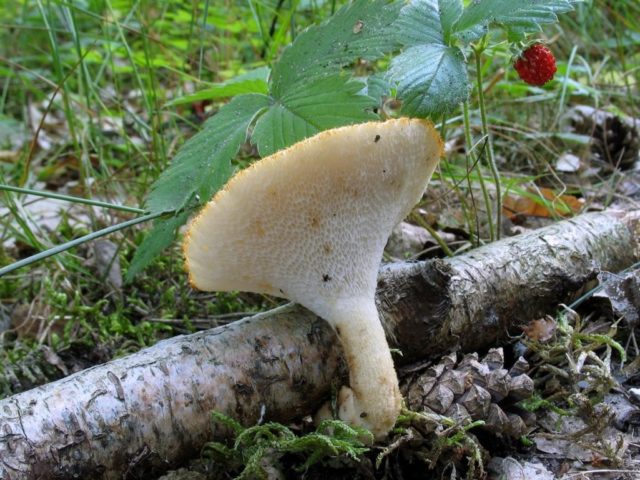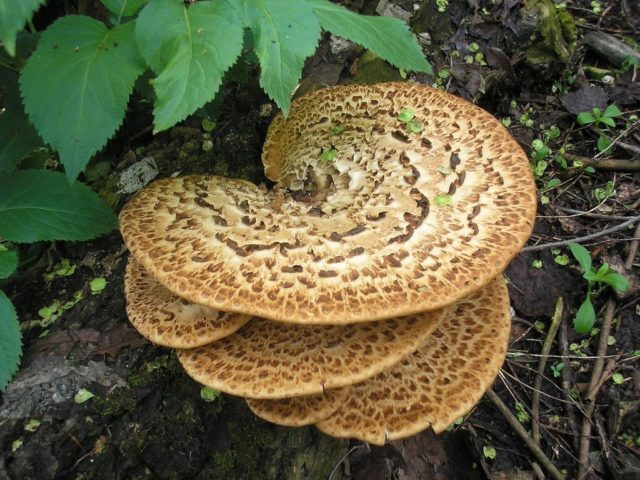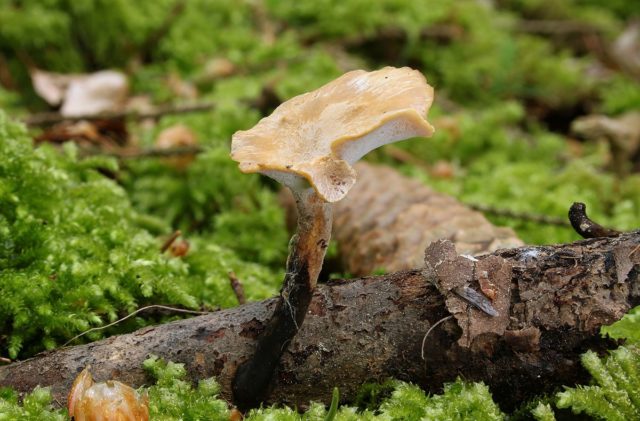Content
Tuberous polypore is a conditionally edible tubular mushroom of the Polyporovye family, the Polyporus genus. Refers to saprophytes.
Description of the tuberous tinder fungus
Many different mushrooms can be found in the forest. To distinguish tuberous tinder fungus, it is important to study its structure and features.

The fungus grows on rotten wood
Description of the hat
The color is yellowish-reddish. Size - from 5 to 15 cm in diameter, sometimes up to 20 cm. The shape of the cap is round, slightly depressed in the middle. Its surface is covered with small, brownish, tightly pressed scales, which cover the middle especially densely and form a convex symmetrical pattern. This pattern is not particularly noticeable in older mushrooms.
The pulp of tuberous tinder fungus has a pleasant smell and an unexpressed taste. It is whitish in color, rubbery, elastic. It becomes watery when it rains.
The spore-bearing tubular layer is descending, whitish or grayish, with a radial pattern. The pores are rather large, infrequent, and elongated. The powder is white.

The hats have a characteristic scaly pattern
Leg description
The height of the leg is up to 7 cm, sometimes it reaches 10 cm, the diameter is 1.5 cm. The shape is cylindrical, widened at the bottom, often curved, attached to the cap in the center. It is solid, fibrous, dense, tough. Its surface is reddish or brownish.

This tinder fungus has a central location
Where and how it grows
Tuberous tinder fungus is found throughout the European part of Russia. It settles on acidic soils in mixed or deciduous forests, where there are aspen and linden trees. It grows on weak or dead wood, sometimes it can be seen on woody substrate.
Fruiting time begins in late spring, continues throughout the summer, and ends around mid-September.
Is the mushroom edible or not
Tuberous tinder fungus is conditionally edible. It is not used for food due to its low taste. Some mushroom pickers use it to make aromatic spices for the first and second courses. To do this, it is dried, then ground into a powder in a coffee grinder. The taste is unusual, delicate.
Doubles and their differences
The main difference between the tuberous tinder fungus is huge disputes. There are two more features: relatively small fruiting bodies and a central stalk.
The similar ones include 2 types.
Scaly polypore... Its main difference is its large size, thick pulp, small tubes in the spore-bearing layer. The cap is very fleshy, leathery, yellowish, fan-shaped, with a thin edge; on its surface there are dark brown scales, which form a symmetrical pattern in the form of circles. At first it is reniform, then it becomes prostrate. The pulp is dense, juicy, with a pleasant aroma, woody in old mushrooms. Its diameter is from 10 to 40 cm. The pores of the tubules are large and angular. The leg is lateral, sometimes eccentric, thick, short, covered with brown scales, darker towards the root, light and reticulate above. In young specimens, its flesh is white, soft, in mature specimens, it is cork. Grows on weak and living trees, singly or in groups. Prefers elms.Found in deciduous forests of southern regions and parks, in the middle lane does not come across. The fruiting period is from late spring to August. The mushroom is conditionally edible, belongs to the fourth category.

Scaly tinder fungus is large in size
Tinder fungus... This mushroom, in contrast to the tuberous tinder fungus, has a uniform cap color, there are no scales that create a symmetrical pattern. Fruit bodies are small - no more than 5 cm. They develop on thin fallen branches. In a young specimen, the edge of the cap is tucked up, unfolds as it grows. In the middle, a rather deep funnel persists throughout life. The surface is smooth, yellow-brown or ocher. In old ones it fades, becomes fibrous. The tubules are very small, light ocher in color, running down to the stem. The pulp is thin, leathery, elastic, with a pleasant smell. The stem is central, velvety, dense, fibrous, straight, slightly widened at the cap, the surface is dark brown or black. It is quite long and thin (height - up to 7 cm, thickness - 8 mm). It grows in various forests on stumps and remains of deciduous trees, most often beeches. Fruiting time is from July to October. Refers to inedible.

Features of the tinder fungus changeable - dark leg and small size
Conclusion
It is almost impossible to find a mature tuberous tinder fungus intact. The fact is that at the beginning of development it is affected by insect pests, it quickly becomes unusable.








